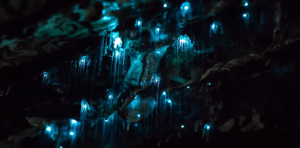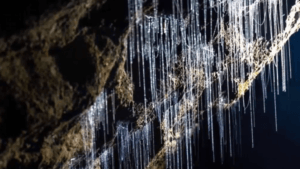How Glow Worms Create Their Magical Light
Glow worms, or more precisely the larval stage of fungus gnats, produce light through a fascinating process known as bioluminescence. This remarkable phenomenon involves a chemical reaction that emits light, a trait shared with other bioluminescent organisms like fireflies and some marine creatures.
The Science Behind Bioluminescence
- Chemical Reaction: The core of this luminescent process lies in the interaction between a molecule called luciferin and an enzyme known as luciferase. When luciferin reacts with oxygen in the presence of luciferase, light is produced. This reaction is powered by adenosine triphosphate (ATP), which provides the necessary energy for the reaction.
- Unique Chemistry: Studies have revealed that New Zealand’s glow worms, specifically the species Arachnocampa luminosa, exhibit a unique bioluminescent reaction. Their luciferin is distinct from that of other bioluminescent creatures, resulting in a unique light production process.
- Light-Producing Organ: Glow worms possess a specialized light-producing organ located near their tail end. This bioluminescent light is actually a byproduct of their metabolic processes.
- Control of Light: Contrary to popular belief, glow worms cannot instantly switch off their light. They can, however, reduce their glow, although it takes a few minutes. If their light appears to suddenly vanish, it might be because they have moved into a crack or crevice, hiding their light.

Experiencing the magic of glow worms in New Zealand is an unforgettable adventure. Here’s a personalized take on these fascinating creatures and the enchanting world they inhabit:
Glow Worms: Nature’s Tiny Light Show
Not Actually Worms: Despite their name, glow worms are actually the larval stage of a type of insect called the fungus gnat. They create a captivating light display in dark, damp environments like caves and forests.
Appearance: These larvae are small, typically ranging from 2mm to 40mm in length, and have a transparent body with a bright green or blue light at the end of their tail. This glowing light is what makes them so mesmerizing.
Habitat
Preferred Environment: Glow worms thrive in still, dark, and damp places. They need these conditions to avoid direct sunlight and to efficiently catch their prey. This makes caves, like the famous Waitomo Caves in New Zealand, the perfect habitat for them.
Distribution: These incredible creatures are found in both New Zealand and Australia, with New Zealand being home to the unique species Arachnocampa luminosa.

Life Cycle
Egg Stage: The life cycle of a glow worm starts when adult female fungus gnats lay eggs.
Larval Stage: Once the eggs hatch, the larvae (glow worms) emerge and begin to glow. They use this light to attract their prey, creating an ethereal glow in the darkness.
Pupal Stage: After several months as larvae, they transition into the pupal stage.
Adult Stage: Adult fungus gnats emerge from the pupae, ready to mate and lay eggs, thus continuing the cycle of life.

Luring and Catching Prey
Glowing Light: The bioluminescent light produced by glow worms is used to lure small flying insects, such as mosquitoes and midges.
Fishing Lines: To catch their prey, glow worms spin sticky webs known as “fishing lines.” When an insect gets ensnared in these lines, the glow worm reels it in and consumes the trapped insect.
Interesting Facts
Unique to New Zealand: The species Arachnocampa luminosa is unique to New Zealand, making it a special part of the country’s natural heritage.
Magical Displays: Visiting glow worm caves, like the Waitomo Glowworm Caves, offers a breathtaking experience. The sight of thousands of glow worms creating a starry night sky effect in the dark cave is nothing short of magical.
Exploring the Wonders of Waitomo: A Guide to New Zealand’s Glowworm Caves

